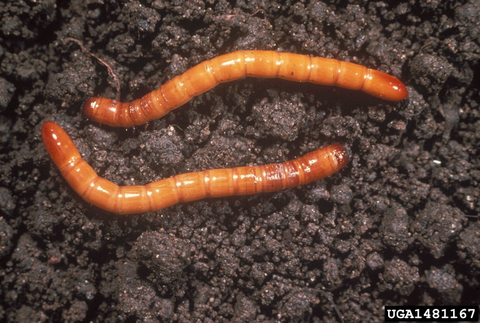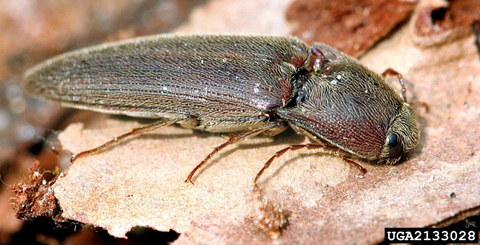Identification of wireworm (family: Elateridae, multiple species)
Adults
Adults (Figure 1b) are known as "click beetles"
- Brown or black, bullet shaped.
- All have a flexible area between the first and second section of the thorax, which allows the beetle to catapult itself and creates a "clicking noise."
Eggs
Eggs are small and pearly white and are laid in the soil.
Larvae (Figure 1a)
- Slender and hard–bodied.
- Range in color from yellow to brown.
- Size can vary from one-half to 1.5 inches long.
Pupae
Pupae are white to tan colored, one-half to 1.5 inches long and seldom seen.
Natural history
Wireworms have an extended life cycle, requiring one to six years to complete a single generation. Because of this variation, all stages of wireworm can be found at any given time.
Depending on species, both larvae and adults can overwinter. After adults become active in mid to late spring, they mate and lay eggs in the soil.
Eggs hatch in three to four weeks. As larvae develop, they move up and down within the soil profile for multiple years. Eventually, they pupate in the soil and emerge the following spring.
Impacts
Wireworms feed directly on germinating soybean seeds and also on soybean roots, which can cause stand loss or stunt plants.
Wireworm injury occurs mainly during the early stages of plant growth.
Scouting and management
There are no rescue treatments for wireworm. Once wireworm injury is noticed, it is too late to use any control methods. All management decisions need to be made prior to planting.
Risk for infestation by wireworm is greater under the following conditions:
- Fields with a history of infestation by this pest.
- Fields previously in pasture, sod, CRP, or similar situations.
- Early planting accompanied by cold weather.
Scouting – bait sampling
Sampling for wireworms is done prior to planting through the use of bait stations (Figure 2). Bait stations are established in the following way:
- Create a mixture of untreated corn and wheat (one-half cup total) and soak in water for 24 hours.
- Dig a hold approximately 4 inches deep by 10 inches wide, and bury the mixture. Mound the soil over the top in a dome shape so rainwater runs off.
- Cover the mound with black plastic and mark the station with a flag.
- After one week, collect the bait from each station and calculate the average number of wireworm larvae.
- 10 bait stations per field is recommended.
- If more than one wireworm per trap is found, the risk of crop injury is high.
Chemical control
Rescue treatments are not available for this pest. Preventative use of seed–applied or in–furrow insecticides may be considered for fields with high risk for economic infestation by wireworm (see above risk factors). Follow instructions on the insecticide label.
Estimation of stand loss and replant decisions
Fields should be inspected for stand loss during seedling growth stages. Soybean is a resilient crop, able to tolerate relatively high levels of stand loss. However, when significant stand loss occurs because of wireworm or other causes, replanting may be required, but this option should be considered carefully. Information is available on how to estimate plant stand and guide replant decisions in soybean. See the University of Minnesota Extension Soybean grower's field guide for evaluating crop damage and replant options.
Reviewed in 2015




